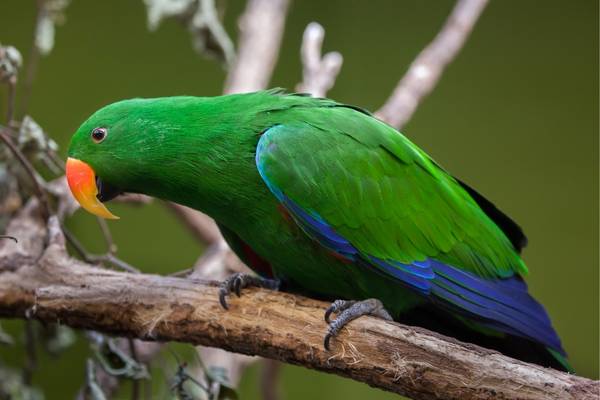The animal world can seem a little cruel and difficult to understand at times, particularly when it comes to how different species will treat their young. You might have wondered, do birds kill their own babies?
Some birds will kill off their offspring if there are not enough food resources to go around, or if they are likely to cause harm to the rest of the brood. Baby birds can also die from neglect or abandonment, though this is rarely just because they have been touched by a human.
Read ahead in this article to find out why some birds might kill their babies, and whether humans might inadvertently make this happen by interfering with a nest.
Table of Contents
- Why Would a Mother Bird Kill Her Babies?
- Which Bird Species Are Known to Kill Their Babies?
- Do storks kill their babies?
- Will Birds Also Eat Their Own Babies?
- Do Birds Kill Their Babies If You Touch Them?
- What Do Birds Do When Their Babies Die?
- What can you do to prevent birds from killing their own babies?
- Conclusion
- FAQs
- Do blue jays kill their babies?
- Do mourning doves kill their babies?
- Do quails kill their babies?
- Why do quails kill their babies?
- Do budgies kill their babies?
- Do geese kill their babies?
- Do crows kill their babies?
- Do Canadian geese kill their babies?
- Do swans kill their babies?
- Do parakeets kill their babies?
- Do finches kill their babies?
- Do zebra finches kill their babies?
- Why would zebra finches kill their babies?
- Do chickens kill their babies?
- Do cardinals kill their babies?
- Do robins kill their babies?
- Do hawks kill their babies?
- Do sparrows kill their babies?
- Do mother ducks kill their babies?
- More About Backyard birds in North America
Why Would a Mother Bird Kill Her Babies?
It is not a myth that some mother birds will kill their babies, but it is not a very common phenomenon. Birds spend a lot of time and energy caring for their young and are often among the most devoted mothers in the animal kingdom.
Almost all species are instinctively driven to survive and reproduce, so why might a mother bird choose to cause the death of her offspring? There are three main reasons why birds have been recorded as actively killing their babies.
- Brood reduction: Mother birds will sometimes kill their babies because they do not have the food resources or nest conditions needed to keep their entire brood alive. Some birds may reduce their brood size so that the limited food or space they have can be given to the healthiest of their offspring, or even be kept for themselves!
- Preventing the spread of infection: If a baby bird is sick with an infection that may spread to the other nestlings or the adult birds, a mother may kill the infected baby or discard them.
- Reducing the breeding success of competing birds: As with many other species, birds have been known to kill the offspring of other parents that they are competing with so that their own babies are more likely to survive.
- To gain attention from dominant males: A rare phenomenon in birds, but the house sparrow females are notorious for killing off other females’ offspring – partly to establish dominance!They do this especially when they replace previous mates of attractive male sparrows with large territories. Partly because they do not want to spend the energy raising other females’ nestlings, but also to demonstrate some kind of dominance over other female competitors!

It is actually more common for baby birds to die from neglect or abandonment than it is for them to be killed directly by their mother. These are often accidental deaths, though, as most bird species are very caring and attentive parents.
Which Bird Species Are Known to Kill Their Babies?
Infanticide is a rare occurrence in birds, but some bird species do seem to be a little less caring than others. So, who are some of the main culprits?
Eclectus Parrots
These parrots are known to kill their young if their nests are not able to support the entire brood.

They usually choose to kill the youngest male sibling first so that older female nestlings will develop more quickly. They do this as they know (by instinct!) that females take less work and food to raise!
Black Eagles
Although black eagle mothers are not necessarily killers themselves, they often let their offspring kill each other without interfering.
When baby black eagles fight, they can sometimes fight to the death, and the mothers will rarely intervene. This allows the strongest of their young to survive.
Cuckoos
You’ve probably heard of the strange way that some cuckoos “care” for their young. They can lay their eggs in the nests of other birds, turning their own babies into “brood parasites”.

Baby cuckoos will often kill off the offspring of the host bird so that they can be raised without competition.
House Sparrows
The males of this widespread bird species are actually known to go out of their way to hunt down and kill the babies of competing males so that their young are more likely to survive. But females will actually do the same, which is unusual for birds!
In fact, more than 10% of new house sparrow nestlings are brought up in a nest where the male (or much rarer, the female) has first killed off the offspring of the previous partner to one of the parents!

Although this behavior is almost always carried out by males in other bird species, house sparrow females are notorious for killing the nestlings of competing females!
They seemingly do this to get more attention from polygamous males and to advance in the social hierarchy.
Do storks kill their babies?
Yes! White Storks have been known to kill their babies and a 3-year-long study found that 9 out of 63 nests experienced infanticide. This means that it only happens in 14% of the nesting couples, but less often if conditions are optimal and perhaps more often if food is scarce.
Why do storks kill their babies?
Storks will kill their babies if they lay too many eggs and therefore have to care for more than they can carry. In other bird species, the nestlings would outcompete each other “naturally” and the parents would not need to intervene, but not in storks.
Therefore, the stork parents will often intervene themselves to put an end to the smallest chick’s misery before it starves to death.
Will Birds Also Eat Their Own Babies?
As a biologist with a keen interest in avian behavior, I can provide insight into the intriguing topic of cannibalism in birds. While it may be unsettling to imagine, yes, there are instances where certain bird species engage in cannibalistic behaviors, including consuming their own offspring.
Although this behavior is relatively rare among birds, it has been observed in various contexts and can serve different purposes depending on the species and circumstances involved.
One important point to emphasize is that the vast majority of bird species do not exhibit cannibalistic tendencies towards their young. Parental care and nurturing instincts are deeply ingrained in most avian species, as they invest significant time and energy in rearing their offspring.
The act of killing and consuming their own young goes against the typical parental behavior observed in birds, which is geared towards ensuring the survival and well-being of their progeny.
Nevertheless, there are several factors that can contribute to instances of cannibalism in birds. These factors include food scarcity, competition for resources, stress, environmental conditions, and even genetic predispositions.
In certain cases, a parent bird may perceive their own offspring as a potential source of nutrition, especially when food availability is limited or unpredictable. By consuming their young, the parent bird gains sustenance to survive during challenging times.
In addition to nutritional benefits, cannibalism in birds can also serve other purposes. One such purpose is related to maintaining the overall fitness of the parent bird. By eliminating weaker or sickly offspring through cannibalism, the parent bird can allocate its limited resources towards raising the healthier offspring, thus increasing the chances of their survival and overall reproductive success.
This behavior, known as “culling,” ensures that the limited resources are allocated to the strongest individuals who have a higher likelihood of passing on their genes to the next generation.
It is important to note that cannibalism in birds is not limited to parents consuming their own young. In some cases, unrelated adult birds may prey upon the young of other individuals within their own species.
This type of cannibalism can occur as a result of territorial disputes, dominance hierarchies, or simply as a opportunistic feeding behavior.
Certain species of birds, such as gulls and raptors, have been observed engaging in this behavior, particularly when food resources are scarce or when defending their nesting territories.
It is crucial to understand that cannibalism in birds is not the norm, but rather an exception to the typical parental care exhibited by avian species. The majority of bird parents invest significant effort in protecting, feeding, and nurturing their young, ensuring their survival and eventual independence. Cannibalism, when it does occur, is generally a result of exceptional circumstances and environmental pressures.
In conclusion, while it may be unsettling to contemplate, cannibalism in birds, including the act of consuming their own offspring, has been observed in certain species. This behavior can be driven by factors such as food scarcity and the need to prioritize the survival of the fittest offspring.
However, it is important to remember that such behaviors are not representative of the broader avian population. Most birds exhibit remarkable parental care and strive to ensure the well-being and success of their young.
Do Birds Kill Their Babies If You Touch Them?
You’ve probably been told to leave a baby bird alone if you spot one out in the wild because its mother will kill it if it has a human smell, but is this true?
Actually, this idea is a myth, although the advice that it has produced is actually pretty sensible.
Birds will not kill their babies just because they have been touched by humans, and a human smell is not going to cause a baby to be abandoned.
The problem with touching a baby bird is that your presence is likely to scare off the parents, and the adult birds may find it difficult to locate them again.

It’s best to leave a baby bird where you find it because you want its parents to come back, and they are more likely to do so if you’re not around.
If the birds are older at the fledgling state, the bird might not belong in the nest anymore and will take care of by the parents. In if that is the case, you should not move it or try to rescue it!
What Do Birds Do When Their Babies Die?
When baby birds do die, it can seem very sad to us, but do the adult birds become upset? What do they do when this happens? Well, it’s hard to determine exactly how much emotion birds have.
There is no scientific proof that birds will mourn or grieve, but some of their behavior does suggest a level of sadness.
For example, penguins are known to hold onto their young for a long time even after they have died, crows have been observed gathering around their dead, and magpies will sometimes place objects over the bodies of deceased birds.

As for what actually happens when a baby bird dies, things are a little more practical. Dead bodies breed bacteria and attract predators, so they need to be removed from the nest.
The larger the baby is, the further they will be taken away. Many predatory and scavenger birds, like vultures and hawks, will even eat their young, though this does not seem to be done out of maliciousness, but simply because it is expedient.
In the end, though we may never know for sure what goes on in a bird’s mind when its young die, we can see that they do take some actions that could be interpreted as signs of sadness.
What can you do to prevent birds from killing their own babies?
You always have to be careful when trying to help birds as the reason for their behaviour can vary and you might make it worse!
Some possible reasons for bird infanticide include if the bird is sick, stressed or hungy, if the bird feels threatened, if the baby is not healthy, or if the mother bird is simply inexperienced.
If you are concerned about birds killing their own babies, you can try to provide nesting materials and a safe environment for them to nest in.

You can also try putting out extra food for them in your yard. I have already written extensively about how to feed backyard birds in each state of the US here on the site – so just go and find the bird in question and read all about what to feed it in my posts on backyards birds!
I will put some links at the end of this post as well!
Conclusion
As much as we might not understand it, killing babies is a natural occurrence in the animal world. For birds, it usually happens when the mother bird is trying to protect her (future) offspring or ensure their success.
While it’s a myth that human touch will cause a mother bird to kill her baby, it’s best to leave them alone so as not to scare off the parents. And if a baby bird does die, the adult birds usually handle it by removing the body from the nest without measurable remorse.
FAQs
Do blue jays kill their babies?
There are many factors that can affect the behavior of blue jays. Some reports suggest that blue jays may kill their babies if they perceive a threat to their safety, while other reports indicate that blue jays are generally gentle and nurturing parents. Ultimately, it is important to remember that every animal is unique and therefore reactions to different situations will vary.
Do mourning doves kill their babies?
No, mourning doves are not known to kill their babies.
Do quails kill their babies?
There is no definitive answer to this question as different quail species exhibit different behaviors. But some species might do so.
Why do quails kill their babies?
Some quail birds will kill their own babies if they perceive them to be a threat, while others will not. It is speculated that quails may kill their babies if they are sick or deformed in some way, in order to prevent the spread of disease.
Do budgies kill their babies?
Some budgies may kill their babies if they feel threatened or if they are not getting enough food, while others may not kill their babies under any circumstances.
Do geese kill their babies?
No, geese do not kill their babies. They are herbivores and would not normally be aggressive against their young.
Do crows kill their babies?
Crows will gladly eat other bird’s eggs and babies but do rarely eat their own offspring. Some crows may kill their babies if they perceive them to be a threat to their survival during food shortage.
Do Canadian geese kill their babies?
No, geese do not kill their babies. They are herbivores and would not normally be aggressive against their young.
Do swans kill their babies?
Swans, like geese, are herbivorous birds that do not normally have a taste for meat. They have very few babies so they will not let them go to waste. And whereas they will never kill their own babies, they will sometimes kill the nestlings of competing swan couples!
Do parakeets kill their babies?
No, parakeets do not kill their babies. Parakeets are small, gentle birds that typically make great parents.
Do finches kill their babies?
No, finches do not kill their babies. They are small, seed-eating birds that typically have large clutches of eggs (6-8). The female will incubate the eggs and both parents will feed the chicks once they hatch.
They may sometimes peck them by accident and kill them unintentionally. They will then throw them out of the nest where they will day from the fall if not completely dead already.
Do zebra finches kill their babies?
Zebra finches are very similar to regular finches and do not kill their babies on purpose.
Why would zebra finches kill their babies?
Zebra finches would only kill their babies by accident and never intend to do so on purpose. Especially when held in captivity where food is usually plentiful. They may sometimes peck them on accident as they are not the most intelligent birds around!
Do chickens kill their babies?
Chickens only kill their babies if they are hurt or injured. Sometimes they will eat their own eggs if they are free-range. However, they would only do this if they could not lay another egg that day and needed to conserve their energy.Chickens are omnivorous birds, but they mostly eat plants. They will only eat meat if it is available, but they do not hunt for it.
Do cardinals kill their babies?
As cardinals have very strong family bonds, it is unlikely they would kill their babies but it is possible. Cardinals will only kill their babies if they are severely disturbed or stressed.
Do robins kill their babies?
I have never heard any reports of robins killing their babies. So at least, they are not well known to do so.
Do hawks kill their babies?
Hawks are predators and will kill baby animals for food, including other birds, but they rarely kill their own babies as they do not have large broods.
Do sparrows kill their babies?
Yes! As mentioned earlier in this post, house sparrows kill almost ten percent of their total offspring if we count across and between couples!
Do mother ducks kill their babies?
No, ducks do not kill their babies.

And let’s end this post on a happy note: In fact, duck mothers are very nurturing and will often incubate other duck’s eggs and raise their chicks if given the chance!
More About Backyard birds in North America
Are you interested in how the backyard birds in your state compare to other states?
Then check out my other blog posts below:
- Backyard birds of Alabama
- Backyard birds of Colorado
- Backyard birds of Delaware
- Backyard birds of Georgia
- Backyard birds of Hawaii
- Backyard birds of Illinois
- Backyard birds of Iowa
- Backyard birds of Kentucky
- Backyard birds of Louisiana
- Backyard birds of Maryland
- Backyard birds of Massachusetts
- Backyard birds of Missouri
- Backyard birds of Nebraska
- Backyard birds of New York
- Backyard birds of North Carolina
- Backyard birds of Oklahoma
- Backyard birds of Rhode Island
- Backyard birds of South Carolina
- Backyard birds of Tennessee
- Backyard birds of Texas
- Backyard birds of Virginia
- Backyard birds of West Virginia
- Backyard birds of Wisconsin
- Backyard birds of Wyoming
And in Canada:
- Backyard birds of Ontario
- Backyard birds of Prince Edward Island
- Backyard birds of Saskatchewan
- Backyard birds of Quebec
Not on the list? Check out the rest of my posts on backyard birds here!
Maybe you would like to know if the Blue Jay or Cardinal dominates in the bird feeder hierarchy or how birds such as seagulls sleep at night? Or why mourning doves poop so much.
My Favorite Backyard Birding Gear:
If you are interested in posters and other wall arts etc. with drawings of all the backyard birds you have just read about, check out my portfolio over at Redbubble:
https://feederwatch.org/
American Museum of Natural History Birds of North America. DK; Revised edition (September 6, 2016). ISBN: 978-1465443991
National Geographic Backyard Guide to the Birds of North America, 2nd Edition. National Geographic; 2nd edition (October 15, 2019)
Birds of North America. National Audubon Society. (Knopf April 6, 2021). ISBN: 978-0525655671
https://celebrateurbanbirds.org/
https://www.birds.cornell.edu/











































